April 1, 2000: third prototype
Here's a typical San Francisco moment for you: a few months ago I ran into my old neighbor Marie, and her fiancé Chris Whitney, who used to be a stonemason. As we were chatting I found out that Chris had moved on from the stone business and was now doing metal fabrication in his own shop. So I thought, hey, this would be a good guy to ask a few questions about building my crazy device! I described the telestereoscope to him. When I'd finished, he looked at me with wide open eyes and said, "Let's build a really big one!" Then we both laughed a booming, sinister laugh, and for some reason lightning struck outside even though it was a beautiful sunny afternoon.
We've been talking on and off since then, swapping sketches and ideas. And this weekend we built a prototype out of steel.
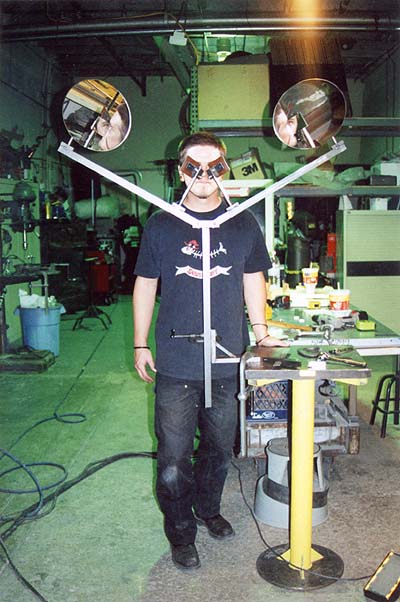
The design features a central post with two movable arms, each of which supports one pair of mirrors. Each mirror is mounted on a bracket whose angle can be adjusted in two directions and then fixed with set screws. The brackets are set on rods, the outer pair fixed in place, and the inner pair attached using sliding brackets that can also be fixed with set screws. We did it this way so we could play around with the angles and distances before making them permanent.
This is intended as a scale model of the one we'll bring to Burning Man. The final one will be three or four times larger, will have a much sturdier post, and the arms will be trussed out for strength.
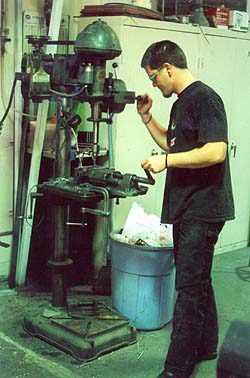
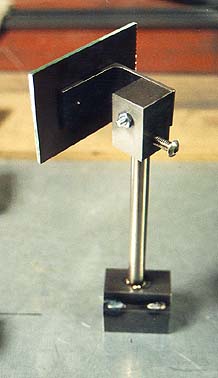
We made most of the parts ourselves. Chris did the sawing, drilling, and welding, and I did the tasks less likely to cost a novice his fingers, like marking centerpoints for the holes, filing burrs off of rough edges, and of course, math.

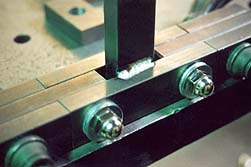
Once all the parts were made, we assembled the beast together, raised the arms to a 30-degree angle above the horizontal, adjusted the positions of the inner mirrors until they were properly spaced, and then fused the arms permanently into that position so they wouldn't slip.

It took very little time to get the mirrors roughly calibrated. This was an unexpected benefit of the raised arms: because the arms aren't parallel, you can sort of home in on the alignment using only one of the swivels on each big mirror. Doing this is kind of like using an etch-a-sketch. It was easy to align the two mirrors to each other. Slightly more difficult will be aligning both of the mirrors with the real world, so that there's no noticeable sideways jump when you first look through the 'scope. And all of this will be a lot tougher on the full-scale model, because the big mirrors will be too far away to reach with your hand while you're looking through the middle. It will take two people to do it, one of them standing on a ladder.
One thing is pretty clear by now: plexiglass mirrors really suck. The ones we're using are already pretty scratched up, and one of them has an annoying internal reflection problem that gives bright lights a whole lot of little ghost echoes on either side. But one improvement from the last model is that there is a lot less warping: we attached the mirrors to the brackets at their centers only, using double-sided tape (which I hope will be strong enough) so there are not so many pressure points to deal with.
All we have to do next is build a base with some kind of bearing to allow the device to swivel around (for the moment, you have to clamp it onto a table in order to use it) and attach some eyepieces to the front, and we'll have a fully functional prototype.
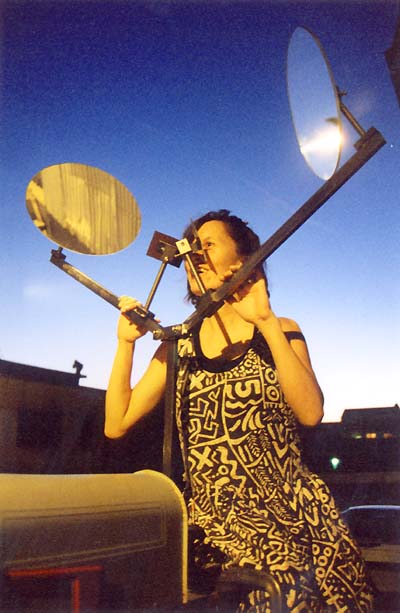
April 8, 2000: adding a base
We reconvened the next weekend to build a base. Chris really did all the work this time around; I just watched and took pictures. The base is cross-shaped with swivel feet and a vertical tube to hold up the optics. The optics assembly is mounted on a smaller tube, which fits inside the tube of the base, and has a sleeve around the top part that matches the radius of the big tube. The sleeve and tube match up, and the surface between them forms a simple bearing (the simplest imaginable bearing, really.) So the whole thing looks like one long tube that's been cut in the middle. Pretty slick work on Chris's part.

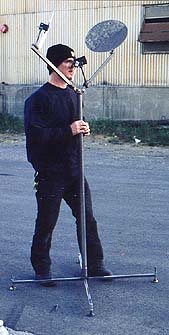
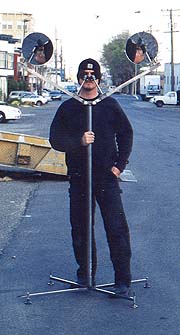
Once the base was assembled, we set the 'scope up outside in the street, and I set about calibrating the mirrors. It was cold and foggy, and loosening the little hex-bolts with numb fingers was a little tricky, especially because the hardware was almost out of reach. But with help from Chris, it only took about ten minutes to get all four mirrors adjusted just right.
It was also pretty windy, so this was a good opportunity to see how the thing would behave under less-than-ideal conditions. Sure enough, the mirrors behaved a bit like propeller blades: the device tended to turn until it was facing into the wind. It also wobbled a little bit. However, it didn't come anywhere near falling over, despite the fact that the base is pretty narrow in proportion to its height.
July 17, 2000: finishing touches
Not a lot of pictures to show here, but here's the latest: Chris and I spent the week adding little finishing touches to V3 of the 'scope. Rubber eyeguards, real glass mirrors. We brought the device to a roof party in the Mission Friday night, and it was a hit with the guests (although it's just too darn tall for most viewers, a design glitch that didn't occur to us until halfway through building it.)
The really good news is that despite being in constant use by people at varying degrees of sobriety, the mirrors stayed calibrated all night, without needing any adjustment. This bodes well for the big one, which we'd really rather not have to babysit too much.
Tonight we do a little show-and-tell at the Exploratorium courtesy of Louis Brill and YLEM and the Burning Man curators. Should be fun!
July 19, 2000: "The Art of Burning Man" show
Chris and I showed off the device to a very enthusiastic and fun bunch at the Exploratorium show. It seemed to get a good response from burners and non-burners alike. The glass mirrors are so much better than those crappy plexiglass ones: much flatter, and there was no ghosting whatsoever, not even from bright outdoor lights at night!
One thing is clear: we will definitely need to provide a way for both short and tall people to enjoy the full-scale device. (A little step-stool just ain't gonna do the trick.) One possibility is to divide our platform into two or more concentric steps, ziggurat-style, so tall folks can stand on the outer steps and short folks can get a boost from the inner ones.
In other news, we just our first order from Surplus Shed, containing a bunch of front-surface mirrors and other fun gewgaws. (Other fun sites for cheap optics: American Science & Surplus, Laser Surplus.) Well, now we're pretty much ready to get started on the big one!